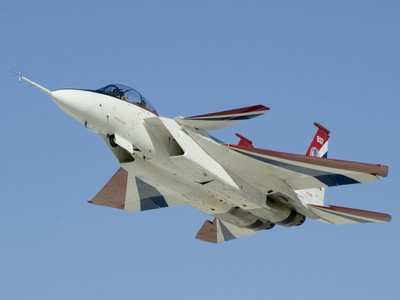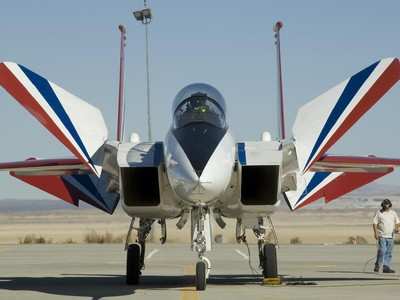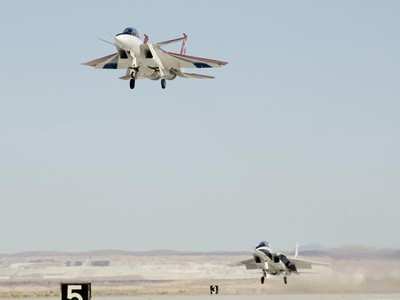Program Aims To Quiet Supersonic Transition
NASA is concluding a series of flight tests to measure shock
waves generated by an F-15 jet, in an effort to validate computer
models that could be used in designing quieter supersonic
aircraft.

The Lift and Nozzle Change Effects on Tail Shock, or Lancets,
project embodies research aimed at enabling the development of
commercial aircraft that can fly faster than the speed of sound
without generating annoying sonic booms over land. Supersonic
flight over land generally is prohibited because of annoyances
caused by such noise.
A sonic boom is created by shock waves that form on the front
and rear of the aircraft. The boom loudness is related to the
strength of the shock waves. The formation of the shock waves is
dependent on the aircraft geometry and the way in which the wing
generates lift.
During the flight tests at NASA's Dryden Flight Research Center
in Edwards, CA, one of two F-15s generally followed 100 feet to 500
feet below and behind the other, measuring the strength of the
leading aircraft's shock waves at various distances with special
instruments. Global Positioning System relative positioning was
used to guide the pilot of the probing aircraft to the test
position and for accurate reporting of measurement locations.

Lancets is the latest in a series of NASA projects investigating
the effects of aircraft geometry and lift on the strength of shock
waves. NASA previously teamed with private companies to study the
effect of aircraft shape on the strength of shock waves and whether
adding a nose spike to an aircraft affects the strength of its
shock waves in order to validate design tools for aircraft
fore-bodies.
NASA's modified NF-15B was the test aircraft for the flights. It
was ideally suited for Lancets because its canards and engine
nozzles can be adjusted in flight.
Canards are small airfoils in front of the wing that are
designed to increase the aircraft's performance. Adjusting the
canards changes the lift of the main wing, which varies how much
wing lift contributes to the strength of the shock waves. This
cannot be done on a conventional aircraft without making expensive
modifications to the wing. Adjusting the engine nozzles alters the
exhaust plumes from the engines, which varies how much the rear of
the aircraft contributes to the strength of the shock waves.
A second NASA F-15B was the probing aircraft. It was fitted with
a special nose spike for taking shock strength measurements.
The flight results will be used by computational fluid dynamics
researchers at NASA's Langley Research Center in Hampton, VA;
NASA's Ames Research Center at Moffett Field, CA; and at Dryden to
develop and validate improved tools that incorporate aft-shockwave
effects in the prediction of sonic booms. The flight data will also
be made available to interested university and industry partners in
order to further their research objectives.

The research is funded and managed by the Fundamental
Aeronautics Program, part of NASA's Aeronautics Research Mission
Directorate at NASA Headquarters in Washington.
 ANN FAQ: Submit a News Story!
ANN FAQ: Submit a News Story! Aero-News: Quote of the Day (06.12.24)
Aero-News: Quote of the Day (06.12.24) ANN's Daily Aero-Linx (06.12.24)
ANN's Daily Aero-Linx (06.12.24) ANN's Daily Aero-Term (06.12.24): Adcock Range
ANN's Daily Aero-Term (06.12.24): Adcock Range Airborne Affordable Flyers 06.06.24: 200th ALTO, Rotax SB, Risen 916iSV
Airborne Affordable Flyers 06.06.24: 200th ALTO, Rotax SB, Risen 916iSV





